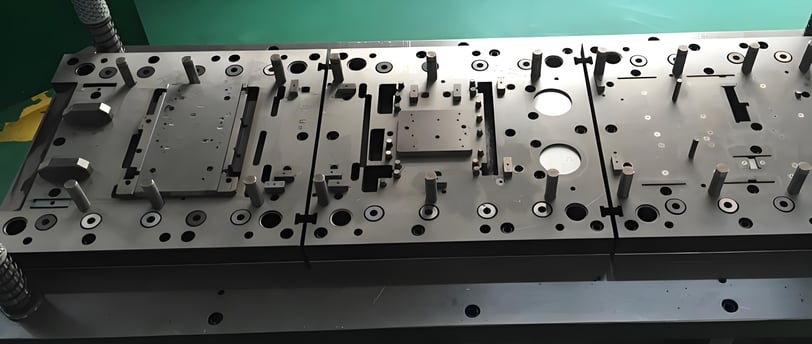How to Solve the Deformation Problem of Stamping Mold
2/16/2025


Understanding Stamping Mold Deformation
Stamping mold deformation is a critical concern in manufacturing, particularly for industries that rely on precision metal fabrication. Deformation refers to the alteration of the original shape or dimensions of a stamping mold due to various factors. Understanding the causes of deformation is essential for ensuring the production of high-quality components, as any alteration can lead to defective parts, increased rejection rates, and heightened production costs.
Several factors contribute to stamping mold deformation. One primary cause is the properties of the materials used in mold construction. Different materials exhibit varying degrees of strength and ductility, influencing their resistance to deformation under stress. For example, a mold made from a high-strength alloy may perform better under high-pressure conditions compared to one made from weaker materials. Thus, selecting appropriate materials is paramount in minimizing deformation risks.
In addition to material properties, design flaws can significantly impact a mold's performance. Poorly designed molds may not distribute stress evenly, leading to localized deformation. Common design issues include inadequate reinforcement in high-stress areas, which can cause bending or warping during the stamping process. Furthermore, over-complicated shapes might exacerbate these problems, as intricate designs can be more susceptible to dimensional changes under varying operational conditions.
Operational conditions also play a crucial role in mold deformation. Factors such as excessive stamping speeds, incorrect die alignment, and variation in material thickness can introduce undue stress on the mold. For instance, if the mold experiences significant temperature fluctuations, it may lead to thermal expansion issues, resulting in warping or dimpling. Recognizing and controlling these elements is vital to maintaining the integrity of stamping molds and ensuring high-quality outputs in production.
Preventive Measures in Mold Design
The prevention of deformation in stamping molds significantly hinges on the principles of effective mold design. One of the primary considerations is the selection of suitable materials. Choosing high-strength materials that can withstand substantial pressure and thermal stress during the stamping process is crucial. Materials such as high-carbon steels or advanced alloys offer enhanced durability, which is imperative for maintaining structural integrity and reducing the likelihood of deformation.
In addition to material selection, proper sizing and dimensioning are vital components of mold design. Each element of the mold must be meticulously calculated to ensure that it can accommodate the stresses encountered during operation. Designers should utilize appropriate tolerances to account for variations in material behavior and to allow for thermal expansion. This careful attention to sizing helps mitigate the risk of accidental deformation that may occur under pressure.
The incorporation of reinforcement structures is another effective strategy in enhancing mold stability. Using ribs or gussets in the mold design can distribute the forces more evenly, thus minimizing stress concentrations that are often precursors to deformation. These structural reinforcements not only improve the mold's ability to withstand physical stresses but also prolong its lifespan, resulting in more efficient production.
Moreover, leveraging simulation software for stress analysis during the design phase is essential. Advanced modeling tools allow designers to simulate the stamping process and evaluate how various stresses will affect the mold. By identifying potential deformation issues before the mold is produced, corrective adjustments can be made proactively. These simulations enhance confidence in the final design, ensuring that the mold will perform optimally under production conditions.
Operational Strategies to Mitigate Deformation
The stamping process is critical in manufacturing, particularly when it comes to shaping materials into precise designs. However, deformation can severely impact the quality and integrity of the stamped products. Implementing effective operational strategies can significantly mitigate the risk of deformation during this process. One primary factor to consider is stamping speed. Adjusting the speed can play a significant role in ensuring materials are processed adequately without undue stress that may lead to deformation. Slower stamping speeds can help in situations where materials are prone to bending or warping, allowing for a more controlled application of force.
Moreover, precise force control is vital in reducing deformation. Monitoring and adjusting the amount of force applied during the stamping process ensures that materials are shaped without overshooting their elastic limits. Utilizing advanced pressure sensors and real-time monitoring technologies can enable operators to make dynamic adjustments as needed. Temperature management is another essential aspect. Certain materials are more susceptible to deformation under high temperatures, hence maintaining a consistent temperature throughout the stamping process can help mitigate this risk. Employing heating or cooling systems judiciously can ensure that the material retains its expected properties, thus aiding in reducing the chances of deformation.
In addition to the above parameters, regular maintenance of tooling is essential. Ensuring that stamping dies are in optimal condition prevents wear that can lead to inaccurate shapes and subsequent deformation. A preventive maintenance program involving routine inspections and timely adjustments not only maintains the equipment but also extends its lifespan. A successful example of these interventions can be observed in industries where routine checks are integrated into daily operations, leading to significantly reduced incidents of deformation. By adopting these operational strategies, manufacturers can enhance the reliability of the stamping process and produce high-quality components consistently.
Case Studies and Lessons Learned
Deformation in stamping molds is a prevalent issue faced by various manufacturing companies. Analyzing real-world case studies reveals valuable insights into effective strategies to mitigate this challenge. One illustrative case involves an automotive parts manufacturer grappling with premature wear and deformation in their stamping molds. The problem stemmed from inadequate cooling systems that caused uneven thermal expansion, leading to warped components. To address this, the company re-engineered their cooling system by implementing enhanced fluid circulation and temperature monitoring technology. The outcome was a significant reduction in mold deformation, resulting in improved product consistency and a 25% decrease in the maintenance costs associated with mold replacements.
Another noteworthy case comes from a consumer electronics company struggling with dimensional inaccuracies due to stamping mold deformation. The manufacturer analyzed their process and discovered that the issue originated from the use of substandard materials that could not withstand the stresses of continuous operation. By investing in higher-quality tool steel and employing advanced heat treatment processes, the company was able to restore dimensional stability in their molds. Ultimately, this transition not only solved the deformation issue but also enhanced the overall durability of the stamping tools, increasing their lifespan by over 40%.
A third example highlights a metal fabrication firm that faced costly production delays due to deformation issues related to inadequate mold design. Upon reviewing their stamping processes, engineers identified the need for improved stress distribution within the mold design. They utilized advanced computer simulations to optimize the geometry of the molds, which effectively reduced stress concentrations during stamping. Following the implementation of these refinements, the company reported a substantial improvement in production efficiency, contributing to reduced cycle times and increased output.
These case studies underscore the importance of a systematic approach in addressing stamping mold deformation. By identifying root causes, implementing targeted solutions, and learning from industry experiences, manufacturers can significantly enhance mold performance and reliability in their stamping operations.
